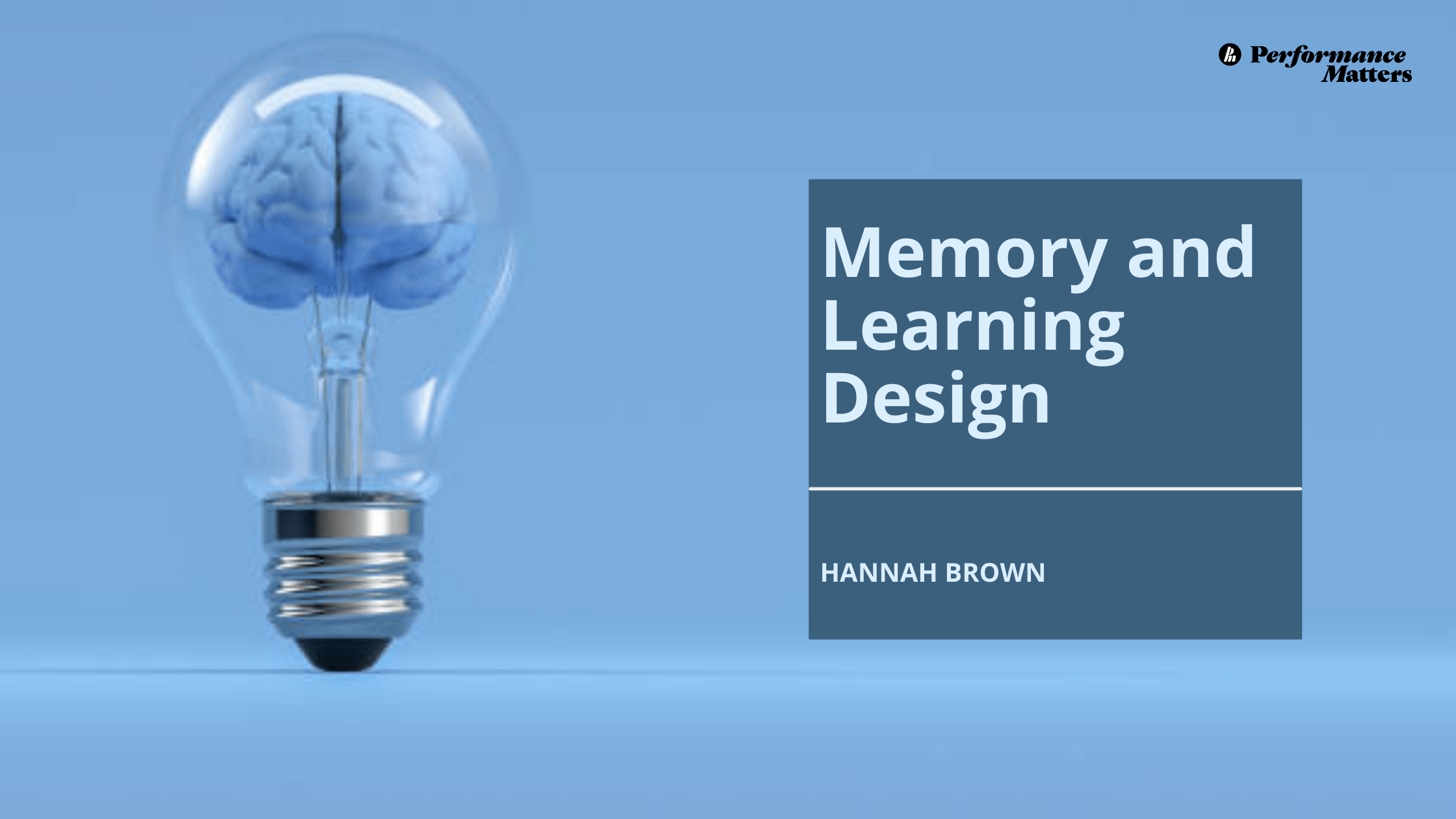My husband has been saying for years that his memory is terrible. In his 20s he bought a book about how to improve your memory. Then he lost it! (True story)
I want to talk about memory and the implications for learning design. There are three different types of memory – sensory, short-term, and long-term. I want to describe each one and then share what it means in terms of how we approach education and learning.
Sensory memory
Sensory is the first layer of memory and is really a filter. It tunes out things that we don’t need to be aware of. As an example, as I’m writing this, I’m suddenly aware that my computer is humming. Usually, my sensory memory blocks it out, so I don’t notice it. Because I’m writing, and it’s quiet in the house, I’m noticing it. So sensory is about whether or not the information is even getting passed into your memory.
Design implications
The design implications of sensory memory are that we want to be consistent with our design but not boring. Consistency is important because it reduces cognitive load. For example, a well-designed e-learning course has navigation buttons in the same place on each screen. The learner doesn’t have to take up precious mental energy trying to figure out where to click to advance in the course.
And yet, we don’t want to be so consistent that we risk becoming boring. Habituation is the process of becoming accustomed to something, so you tune it out. When you’re scrolling online and see banner ads, how often do you actually notice them? If you don’t, it’s because you’ve seen them so many times and you’ve become habituated. We want to avoid habituation when we design training.
Short term memory
Short term is the second type of memory. This is where we remember something long enough to take action. If I think back to my university days, many people, myself included, crammed for tests and exams. We’d store facts in our short-term memory, write the test or the exam, and then forget most of what we had ‘learned’. Studies1 have shown that our capacity to hold things in our memory is about seven. So all that cramming probably wasn’t all that effective. I was probably trying to hold far too much in short-term memory.
Design implications
If we can only hold seven things in our short-term memory, how do we increase our capacity to remember and learn? As designers, we can consider how we chunk content. For example, if you’re making a cake, recipe information is typically grouped – ingredients, instructions for wet ingredients and instructions for dry ingredients. By grouping the information, it’s easier to remember. As designers, we need to look for ways to group content to make it easier to keep in short-term memory for longer.
Long term memory
Our long-term memory is when we encode the information in our short-term memory and keep it for long-term storage. In her book, Design for How People Learn, Julie Dirksen uses a wonderful analogy of your long-term memory being like a closet. When something is passed from short-term memory into long-term memory, it’s like you’re putting it on different shelves or drawers in your closet. The key to long-term memory is to be able to retrieve that information later – knowing in which shelf or drawer that bit of information is filed away.
Design implications
Long-term memory is where learning occurs. It’s the process of encoding information in our memories and then retrieving it. As instructional designers, we need to ask ourselves, “How can I help the person encode this information – get it past sensory and from short-term memory onto a shelf in their long-term memory closet?” Then we need to also help our learners practice retrieving the information so they can use it again over and over. I like to think of encoding as the path you would walk to get to the drawer in your closet. Let’s say you have carpet in your closet. If you retrieve something frequently, the carpet to that shelf would be worn away. Whereas, if you have stored something and access it infrequently, the carpet to that drawer would be like new. There are a few things we can do with our training designs to help this encoding and retrieving process
1. Make sure learning is in context.
For example, if I’m learning CPR in a community center that I’ve never been to, it’s out of context. The CPR steps are stored on a CPR shelf in my closet, but also in a community centre drawer. I’ll probably never go back to that community center, so the fact that it’s stored in that drawer isn’t helpful. If I complete the CPR training on a swimming pool deck, I’ll be more likely to remember it. I go swimming regularly, and a pool is a common place where someone would need CPR.
2. Create an emotional connection.
Look for opportunities for participants to form an emotional connection with the information. This stores the information on an emotional shelf in our closet, which seems to be right at the door, so easy to access. For example, if the instructor tells a personal story about when she performed CPR, the participants will have an easier time retrieving the CPR information. It’s now stored on a CPR shelf, a swimming pool drawer and an emotional shelf.
3. Reinforce retrieval.
The most important thing we can do to help the learning process creates opportunities to practice retrieving information. We want them to start wearing down the path in the carpet when their in our course so the path is established and they can retrieve the information on the job later. Knowledge checks, quizzes and questions are great ways of reinforcing the retrieval process. Returning to the CPR example, in the next swimming lesson, it would be less helpful for the instructor to reteach the steps. That’s repeating the encoding process. The participants have already encoded the information – they need time to practice retrieving it. Instead, the instructor should ask them questions about the steps and have them practice what they learned in the previous session to reinforce what they learned.
As designers, it’s important to consider how people learn and create programs where participants engage with content so they can retrieve it later when they need it. Make sure learning occurs in as realistic a context as possible, make it emotional with a story, and create time for practice.
1 Miller, George A. 1956. “The Magical Number Seven, Plus or Minus Two: Some Limits on Our Capacity for Processing Information.” The Psychological Review (63(2): 81-97.
In case you missed it
I’ve shared some additional posts online. Here they are in case you missed them.
- Curriculum design journey is a puzzle – (video post)
- Training for non-trainers – from consuming to applying – (video post)
- Challenges participants shared at LEARNX – (video post)
- Opening I4PL award 2022 – (video post)
- Hannah Brown is a Sherpa when she works with you – (video post)



